Opossum
| Didelphidae[2] Temporal range: [1]
| |
|---|---|

| |
| Virginia opossum, Didelphis virginiana, the only U.S. and Canadian species (mother with nine young) | |
| Scientific classification | |
| Domain: | Eukaryota |
| Kingdom: | Animalia |
| Phylum: | Chordata |
| Class: | Mammalia |
| Infraclass: | Marsupialia |
| Superorder: | Ameridelphia |
| Order: | Didelphimorphia Gill , 1872
|
| Family: | Didelphidae J. E. Gray, 1821 |
| Type genus | |
| Didelphis Linnaeus, 1758
| |
| Genera | |
|
Several; see text | |
| Diversity | |
| 126 species | |
Opossums (/əˈpɒsəm/) are members of the marsupial order Didelphimorphia (/daɪˌdɛlfɪˈmɔːrfiə/) endemic to the Americas. The largest order of marsupials in the Western Hemisphere, it comprises 126 species in 18 genera. Opossums originated in South America and entered North America in the Great American Interchange following the connection of North and South America.
The
Etymology
The word opossum is derived from the Powhatan language and was first recorded between 1607 and 1611 by John Smith (as opassom) and William Strachey (as aposoum).[5] Siebert reconstructs the word phonemically as /a·passem/.[6] Possum was first recorded in 1613. Both men encountered the language at the English settlement of Jamestown, Virginia, which Smith helped to found and where Strachey later served as its first secretary.[7] Strachey's notes describe the opossum as a "beast in bigness of a pig and in taste alike," while Smith recorded it "hath an head like a swine ... tail like a rat ... of the bigness of a cat."[7] The Powhatan word ultimately derives from a Proto-Algonquian word (*wa·p-aʔθemwa) meaning "white dog or dog-like beast."[7]
Following the arrival of Europeans in Australia, the term possum was borrowed to describe distantly related Australian marsupials of the suborder Phalangeriformes,[8] which are more closely related to other Australian marsupials such as kangaroos.
They similarly have didelphimorphia, two (di) wombs (delphus), the second being a non-bilateral marsupial womb (nursing-pouch).[9]
Evolution
Opossums are frequently considered to be "
Opossums probably originated in the
Large opossums likeCharacteristics
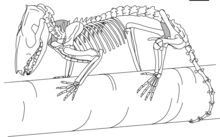
Didelphimorphs are small to medium-sized marsupials that grow to the size of a house cat. They tend to be semi-
Didelphimorphs have a
Although all living opossums are essentially opportunistic

Reproduction and life cycle
As marsupials, female opossums have a reproductive system that includes a bifurcated vagina and a divided uterus; many have a marsupium, the pouch.[30] The average estrous cycle of the Virginia opossum is about 28 days.[31] Opossums do possess a placenta,[32] but it is short-lived, simple in structure, and, unlike that of placental mammals, not fully functional.[33] The young are therefore born at a very early stage, although the gestation period is similar to that of many other small marsupials, at only 12 to 14 days.[34] They give birth to litters of up to 20 young.[35] Once born, the offspring must find their way into the marsupium, if present, to hold on to and nurse from a teat. Baby opossums, like their Australian cousins, are called joeys.[36] Female opossums often give birth to very large numbers of young, most of which fail to attach to a teat, although as many as thirteen young can attach,[37] and therefore survive, depending on species. The young are weaned between 70 and 125 days, when they detach from the teat and leave the pouch. The opossum lifespan is unusually short for a mammal of its size, usually only one to two years in the wild and as long as four or more years in captivity. Senescence is rapid.[38]
Opossums are moderately
Behavior
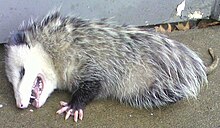
Opossums are usually solitary and nomadic, staying in one area as long as food and water are easily available. Some families will group together in ready-made burrows or even under houses. Though they will temporarily occupy abandoned burrows, they do not dig or put much effort into building their own. As nocturnal animals, they favor dark, secure areas. These areas may be below ground or above.[41][42]

When threatened or harmed, they will "
Some species of opossums have prehensile tails, although dangling by the tail is more common among juveniles. An opossum may also use its tail as a brace and a fifth limb when climbing. The tail is occasionally used as a grip to carry bunches of leaves or bedding materials to the nest.[44] A mother will sometimes carry her young upon her back, where they will cling tightly even when she is climbing or running.
Threatened opossums (especially males) will growl deeply, raising their pitch as the threat becomes more urgent. Males make a clicking "smack" noise out of the side of their mouths as they wander in search of a mate, and females will sometimes repeat the sound in return. When separated or distressed, baby opossums will make a sneezing noise to signal their mother. The mother in return makes a clicking sound and waits for the baby to find her. If threatened, the baby will open its mouth and quietly hiss until the threat is gone.[45]
Diet
Opossums eat insects, rodents, birds, eggs, frogs, plants, fruits and grain. Some species may eat the skeletal remains of rodents and roadkill animals to fulfill their calcium requirements.[46] In captivity, they will also eat dog food, cat food, and human food waste.
Many large opossums (Didelphini) are immune to the venom of rattlesnakes and pit vipers (
Habitat
Opossums are found in North, Central, and South America. The Virginia opossum lives in regions as far north as Canada and as far south as Central America, while other types of opossums only inhabit countries south of the United States.[51] The Virginia opossum can often be found in wooded areas, though its habitat may vary widely.[52] Opossums are generally found in areas like forests, shrubland, mangrove swamps, rainforests and eucalyptus forests.[53] Opossums have been found moving northward.[50][54]
Hunting and foodways
The
In Dominica, Grenada, Trinidad, Saint Lucia and Saint Vincent and the Grenadines, the common opossum or manicou is popular and can only be hunted during certain times of the year owing to overhunting.[72] The meat is traditionally prepared by smoking, then stewing. It is light and fine-grained, but the musk glands must be removed as part of preparation. The meat can be used in place of rabbit and chicken in recipes. Historically, hunters in the Caribbean would place a barrel with fresh or rotten fruit to attract opossums that would feed on the fruit or insects.
In northern/central Mexico, opossums are known as tlacuache or tlacuatzin. Their tails are eaten as a folk remedy to improve fertility.[73] In the Yucatán peninsula they are known in the Yucatec Mayan language as "och"[74] and they are not considered part of the regular diet by Mayan people, but still considered edible in times of famine.
Opossum oil (possum grease) is high in essential fatty acids and has been used as a chest rub and a carrier for arthritis remedies given as salves.[75][76][77]
Opossum pelts have long been part of the fur trade.
Classification
| Cladogram by Upham et al. 2019[78][79] | ||||||||||||||||||||||||||||||||||||||||||||||||||||||||||||||||||||||||||||||||||||||||||||||||||||||||||||||||||
|
| Cladogram by Álvarez-Carretero et al. 2022[80][81] | |||||||||||||||||||||||||||||||||||||||||||||||||||||||||||||||||||||||||||||||||||||||||||||||||||||||||
|
Classification based on Voss (2022), species based on the American Society of Mammalogists (2023)[82][83][84]
- Family Didelphidae
- Subfamily Glironiinae
- Genus Glironia
- Bushy-tailed opossum (Glironia venusta)
- Genus
- Subfamily Caluromyinae
- Genus Caluromys, Caluromys derbianus

Bare-tailed woolly opossum, Caluromys philander 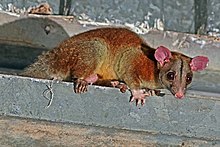
Derby's woolly opossum - Subgenus Caluromys
- Bare-tailed woolly opossum (Caluromys philander)
- Subgenus Mallodelphys
- Derby's woolly opossum (Caluromys derbianus)
- Brown-eared woolly opossum (Caluromys lanatus)
- Subgenus Caluromys
- Genus Caluromysiops
- Black-shouldered opossum (Caluromysiops irrupta)
- Genus
- Subfamily Hyladelphinae
- Genus Hyladelphys
- Kalinowski's mouse opossum (Hyladelphys kalinowskii)
- Genus †Sairadelphys Oliveira et al. 2011
- †Sairadelphys tocantinensis Oliveira et al. 2011
- Genus
- Subfamily Didelphinae
- Tribe Metachirini, Metachirus nudicaudatus

Brown four-eyed opossum - Genus Metachirus
- Aritana's brown four-eyed opossum (Metachirus aritanai)
- Common brown four-eyed opossum (Metachirus myosuros)
- Guianan brown four-eyed opossum (Metachirus nudicaudatus)
- Genus
- Tribe Didelphini

Water opossum, Chironectes minimus - Genus Chironectes
- Water opossum or yapok (Chironectes minimus)
- Genus Lutreolina
- †Lutreolina biforata (Ameghino 1904) Goin & Pardiñas 1996[19]
- Big lutrine opossum or little water opossum (Lutreolina crassicaudata)

Big lutrine opossum, Lutreolina crassicaudata - †Lutreolina materdei Goin & De los Reyes 2011[85]
- Massoia's lutrine opossum (Lutreolina massoia)[86]
- †Lutreolina tracheia Rovereto 1914
- †Genus Hyperdidelphys Ameghino 1904
- †Hyperdidelphys dimartinoi Goin & Pardiñas 1996[19]
- †Hyperdidelphys inexpectata (Ameghino 1889) Marshall 1982[19]
- †Hyperdidelphys parvula Ameghino 1904[19]
- †Hyperdidelphys pattersoni (Reig 1952) Marshall 1982[19]
- Genus Didelphis
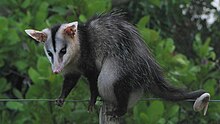
White-eared opossum, Didelphis albiventris Big-eared opossum, Didelphis aurita 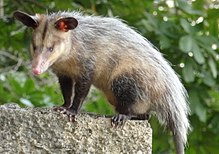
Common opossum, Didelphis marsupialis 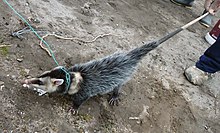
Andean white-eared opossum, Didelphis pernigra - White-eared opossum (Didelphis albiventris)
- Big-eared opossum (Didelphis aurita)
- Guianan white-eared opossum (Didelphis imperfecta)
- Common opossum (Didelphis marsupialis)
- Andean white-eared opossum (Didelphis pernigra)
- †Didelphis solimoensis[87]
- Virginia opossum (Didelphis virginiana)
- Genus Philander
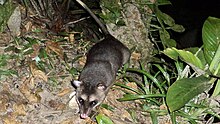
Gray four-eyed opossum, Philander opossum - Anderson's four-eyed opossum (Philander andersoni)
- Common four-eyed opossum (Philander canus)
- Deltaic four-eyed opossum (Philander deltae)
- Southeastern four-eyed opossum (Philander frenatus)
- McIlhenny's four-eyed opossum (Philander mcilhennyi)
- Dark four-eyed opossum (Philander melanurus)
- Mondolfi's four-eyed opossum (Philander mondolfii)
- Black four-eyed opossum(Philander nigratus)
- Olrog's four-eyed opossum (Philander olrogi)
- Gray four-eyed opossum (Philander opossum)
- Pebas four-eyed opossum (Philander pebas)
- Southern four-eyed opossum (Philander quica)
- Northern four-eyed opossum (Philander vossi)
- †Genus Thylophorops Reig 1952
- †Thylophorops chapadmalensis Reig 1952[19]
- †Thylophorops lorenzinii Goin et al. 2009[25]
- †Thylophorops perplana (Ameghino 1904) Goin & Pardiñas 1996[19]
- Genus
- Tribe Marmosini
- Genus †Hesperocynus Forasiepi et al. 2009
- †Hesperocynus dolgopolae (Reig 1952) Forasiepi et al. 2009
- Genus Marmosa
- †Marmosa contrerasi Mones 1980
- Subgenus Eomarmosa
- Red mouse opossum (Marmosa rubra)
- Subgenus Exulomarmosa
- Isthmian mouse opossum (Marmosa isthmica)
- Mexican mouse opossum (Marmosa mexicana)
- Robinson's mouse opossum (Marmosa robinsoni)
- Simon's mouse opossum (Marmosa simonsi)
- Guajira mouse opossum (Marmosa xerophila)
- Zeledon's mouse opossum (Marmosa zeledoni)
- Subgenus Marmosa

Robinson's mouse opossum, Marmosa robinsoni - Quechuan mouse opossum (Marmosa macrotarsus)
- Linnaeus's mouse opossum (Marmosa murina)
- Tyler's mouse opossum (Marmosa tyleriana)
- Waterhouse's mouse opossum (Marmosa waterhousei)
- Subgenus Micoureus

Tate's woolly mouse opossum, Marmosa paraguayanus - Adler's mouse opossum (Marmosa adleri)
- Alston's woolly mouse opossum (Marmosa alstoni)
- White-bellied woolly mouse opossum (Marmosa constantiae)
- Northeastern woolly mouse opossum (Marmosa demerarae)
- Northwestern woolly mouse opossum (Marmosa germana)
- Jansa's woolly mouse opossum (Marmosa jansae)
- †Marmosa laventica Marshall 1976[88]
- Brazilian woolly mouse opossum (Marmosa limae)
- Merida woolly mouse opossum (Marmosa meridae)
- Nicaraguan woolly mouse opossum (Marmosa nicaraguae)
- Tate's woolly mouse opossum (Marmosa paraguayana)
- Peruvian woolly mouse opossum (Marmosa parda)
- Anthony's woolly mouse opossum (Marmosa perplexa)
- Little woolly mouse opossum (Marmosa phaea)
- Bolivian woolly mouse opossum (Marmosa rapposa)
- Bare-tailed woolly mouse opossum (Marmosa rutteri)
- Subgenus Stegomarmosa
- Heavy-browed mouse opossum (Marmosa andersoni)
- Rufous mouse opossum (Marmosa lepida)
- Genus Monodelphis, Monodelphis domestica
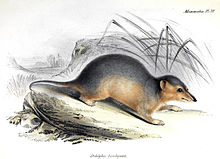
Yellow-sided opossum, Monodelphis dimidiata 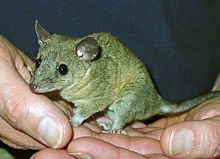
Gray short-tailed opossum - Subgenus Microdelphys
- Northern three-striped opossum (Monodelphis americana)
- Gardner's short-tailed opossum (Monodelphis gardneri)
- Ihering's three-striped opossum (Monodelphis iheringi)
- Chestnut-striped opossum (Monodelphis rubida)
- Long-nosed short-tailed opossum (Monodelphis scalops)
- Southern three-striped opossum (Monodelphis theresa)
- Red three-striped opossum (Monodelphis umbristriata)
- Subgenus Monodelphiops
- Yellow-sided opossum (Monodelphis dimidiata)
- Southern red-sided opossum (Monodelphis sorex)
- One-striped opossum (Monodelphis unistriata)
- Subgenus Monodelphis
- Arlindo's short-tailed opossum (Monodelphis arlindoi)[89]
- Northern red-sided opossum (Monodelphis brevicaudata)
- Gray short-tailed opossum (Monodelphis domestica)
- Amazonian red-sided opossum (Monodelphis glirina)
- Marajó short-tailed opossum (Monodelphis maraxina)
- Hooded red-sided opossum (Monodelphis palliolata)
- Santa Rosa short-tailed opossum (Monodelphis sanctaerosae)[90]
- Touan short-tailed opossum (Monodelphis touan)[89]
- Voss's short-tailed opossum (Monodelphis vossi)
- Subgenus Mygalodelphys
- Sepia short-tailed opossum (Monodelphis adusta)[89]
- Handley's short-tailed opossum (Monodelphis handleyi)[91]
- Pygmy short-tailed opossum (Monodelphis kunsi)
- Osgood's short-tailed opossum (Monodelphis osgoodi)
- Peruvian short-tailed opossum (Monodelphis peruviana)
- Long-nosed short-tailed opossum (Monodelphis pinocchio)
- Reig's opossum (Monodelphis reigi)
- Ronald's opossum (Monodelphis ronaldi)
- Saci short-tailed opossum (Monodelphis saci)[90]
- Subgenus Pyrodelphys
- Emilia's short-tailed opossum (Monodelphis emiliae)
- Subgenus Microdelphys
- Genus †Sparassocynus Mercerat 1898[14]
- †Sparassocynus bahiai Mercerat 1898
- †Sparassocynus derivatus Reig & Simpson 1972
- †Sparassocynus maimarai Abello et al. 2015
- †Sparassocynus heterotopicus Villarroel & Marshall 1983
- Genus †Thylatheridium Reig 1952
- †Thylatheridium cristatum Reig 1952
- †Thylatheridium hudsoni Goin & Montalvo 1988
- †Thylatheridium pascuali Reig 1958
- Genus Tlacuatzin[92]
- Balsas gray mouse opossum (Tlacuatzin balsasensis)
- Tehuantepec gray mouse opossum (Tlacuatzin canescens)
- Yucatan gray mouse opossum (Tlacuatzin gaumeri)
- Tres Marías gray mouse opossum (Tlacuatzin insularis)
- Northern gray mouse opossum (Tlacuatzin sinaloae)
- †Genus Zygolestes Ameghino 1898
- †Zygolestes paramensis Ameghino 1898
- †Zygolestes tatei Goin, Montalvo & Visconti 2000
- Genus †Hesperocynus Forasiepi et al. 2009
- Tribe Thylamyini
- Genus Chacodelphys
- Chacoan pygmy opossum (Chacodelphys formosa)
- Genus Cryptonanus
- Agricola's gracile opossum (Cryptonanus agricolai)
- Chacoan gracile opossum (Cryptonanus chacoensis)
- Guahiba gracile opossum (Cryptonanus guahybae)
- †Red-bellied gracile opossum (Cryptonanus ignitus)
- Unduavi gracile opossum (Cryptonanus unduaviensis)
- Genus Gracilinanus
- Aceramarca gracile opossum (Gracilinanus aceramarcae)
- Agile gracile opossum (Gracilinanus agilis)
- Wood sprite gracile opossum (Gracilinanus dryas)
- Emilia's gracile opossum (Gracilinanus emilae)
- Northern gracile opossum (Gracilinanus marica)
- Brazilian gracile opossum (Gracilinanus microtarsus)
- Peruvian opossum (Gracilinanus peruanus)
- Genus Lestodelphys
- Patagonian opossum (Lestodelphys halli)
- †Lestodelphys juga (Ameghino 1889)
- Genus Marmosops
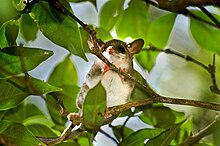
Gray slender opossum, Marmosops incanus - Subgenus Marmosops
- Andean slender mouse opossum(Marmosops caucae)
- Creighton's slender opossum (Marmosops creightoni)
- Dorothy's slender opossum (Marmosops dorothea)
- Tschudi's slender opossum (Marmosops impavidus)
- Gray slender opossum (Marmosops incanus)
- Neblina slender opossum (Marmosops neblina)
- White-bellied slender opossum (Marmosops noctivagus)
- Spectacled slender opossum (Marmosops ocellatus)
- Brazilian slender opossum (Marmosops paulensis)
- Soini's slender opossum (Marmosops soinii)
- Subgenus Sciophanes
- Bishop's slender opossum (Marmosops bishopi)
- Carr's slender opossum (Marmosops carri)
- Cordillera slender opossum (Marmosops chucha)
- Narrow-headed slender opossum (Marmosops cracens)
- Dusky slender opossum (Marmosops fuscatus)
- Handley's slender opossum (Marmosops handleyi)
- Panama slender opossum (Marmosops invictus)
- Junin slender opossum (Marmosops juninensis)
- Río Magdalena slender opossum (Marmosops magdalenae)
- Silva's slender opossum (Marmosops marina)
- Ojasti's slender opossum (Marmosops ojastii)
- Pantepui slender opossum (Marmosops pakaraimae)
- Delicate slender opossum (Marmosops parvidens)
- Pinheiro's slender opossum (Marmosops pinheiroi)
- Woodall's slender opossum (Marmosops woodalli)
- Subgenus Marmosops
- Genus Thylamys
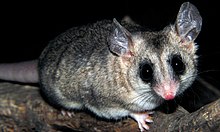
Elegant fat-tailed mouse opossum, Thylamys elegans - Subgenus Thylamys
- Cinderella fat-tailed mouse opossum (Thylamys cinderella)
- Mesopotamian fat-tailed mouse opossum (Thylamys citellus)[93]
- Elegant fat-tailed mouse opossum (Thylamys elegans)
- Paraguayan fat-tailed mouse opossum (Thylamys macrurus)
- White-bellied fat-tailed mouse opossum (Thylamys pallidior)
- Dry Chaco fat-tailed mouse opossum (Thylamys pulchellus)[94]
- Chacoan fat-tailed mouse opossum (Thylamys pusillus)
- Argentine fat-tailed mouse opossum (Thylamys sponsorius)
- Tate's fat-tailed mouse opossum (Thylamys tatei)
- Buff-bellied fat-tailed mouse opossum (Thylamys venustus)
- Subgenus Xerodelpys
- Karimi's fat-tailed mouse opossum (Thylamys karimii)
- Dwarf fat-tailed mouse opossum (Thylamys velutinus)
- †Thylamys colombianus Goin 1997[88]
- †Thylamys minutus Goin 1997[88]
- †Thylamys pinei Goin, Montalvo & Visconti 2000[95]
- †Thylamys zettii Goin 1997[96]
- Subgenus Thylamys
- Genus
- Tribe
- Subfamily
See also
References
- ^ Goin, Francisco; Abello, Alejandra; Bellosi, Eduardo; Kay, Richard; Madden, Richard; Carlini, Alfredo (2007). "Los Metatheria sudamericanos de comienzos del Neógeno (Mioceno Temprano, Edad-mamífero Colhuehuapense). Parte I: Introducción, Didelphimorphia y Sparassodonta". Ameghiniana. 44 (1): 29–71.
- OCLC 62265494.
- ^ "Opossums". National Geographic. Archived from the original on February 21, 2017. Retrieved September 21, 2018.
- ^ "Rabies: A Forgotten Killer Greatest Risk from Wildlife, Especially Bats" (PDF). CDC.
- ISBN 978-0-521-29875-9.
- ISBN 978-0-8203-0334-5.
- ^ a b c Siebert, Frank T. Jr. (1975). "Resurrecting Virginia Algonquian from the Dead: The Reconstituted and Historical Phonology of Powhatan". In Crawford, James Mack (ed.). Studies in Southeastern Indian Languages. University of Georgia Press.
- ^ "possum". The American Heritage Dictionary of the English Language, Fifth Edition. Houghton Mifflin Harcourt. 2014. Retrieved 12 July 2014.
- ^ "Didelphimorphia". Wordnik. Retrieved 21 February 2017.
- ^ a b c d Krause, William J.; Krause, Winifred A. (2006).The Opossum: Its Amazing Story Archived 2012-12-11 at the Wayback Machine. Department of Pathology and Anatomical Sciences, School of Medicine, University of Missouri, Columbia, Missouri. p. 39
- .
- ^ Goin, Francisco; Abello, Alejandra; Bellosi, Eduardo; Kay, Richard; Madden, Richard; Carlini, Alfredo (2007). "Los Metatheria sudamericanos de comienzos del Neógeno (Mioceno Temprano, Edad-mamífero Colhuehuapense). Parte I: Introducción, Didelphimorphia y Sparassodonta". Ameghiniana. 44 (1): 29–71.
- ^ S2CID 10274949.
- ^ S2CID 198190603.
- S2CID 237866763.
- ^ S2CID 88758358.
- ^ S2CID 84680371.
- ^ S2CID 49473591.
- ^ .
- .
- S2CID 84674547.
- S2CID 27200317.
- ISBN 978-0-643-06634-2.
- JSTOR 3504051.
- ^ hdl:11336/67625.
- S2CID 15751319.
- S2CID 83862150.
- S2CID 54177473.
- ^ Gardner, Alfred. Mammals of South America Volume 1. University of Chicago Press. p. 34.
- ^ Campbell, N. & Reece, J. (2005) Biology. Pearson Education Inc.
- ^ Reproduction – Life Cycle. opossumsocietyus.org.
- S2CID 85011250.
- PMID 4061035.
- ISBN 978-0-87196-871-5.
- ^ "Opossums | National Geographic". Animals. 11 November 2010. Archived from the original on February 21, 2017.
- S2CID 24045688.
- ^ a b Virginia Opossum. Didelphis virginiana. Smithsonian National Museum of Natural History.
- ^ Opossum Facts. opossum.org.
- ^ "Possum Hunt". Archived from the original on 2013-11-10.
- PMID 8870084.
- ^ Hamilton, W. J. Jr. (1958). "Life history and economic relations of the opossum (Didelphis marsupialis virginiana) in New York State". Cornell Univ. Agric. Exp. Sta. Memoirs. 354: 1–48.
- ^ "Opossums – Living with Wildlife | Washington Department of Fish & Wildlife". wdfw.wa.gov. Retrieved 2017-05-14.
- ^ Found an Orphaned or injured Opossum?. Opossumsocietyus.org. Retrieved on 2012-05-03.
- S2CID 84782113.
- ^ "Opossum Sounds & Noises: What Do Opossums Sound Like?". www.crittercontrol.com. Retrieved 2022-01-24.
- ^ "What Do Possums Eat? Facts About Their Diet | Terminix". Terminix.com. Retrieved 2020-05-29.
- S2CID 21264310.
- PMID 7846694.
- ^ PMID 23402839.
- ^ ISBN 978-0-8018-7416-1.
- ^ "opossum | marsupial". Encyclopedia Britannica. Retrieved 2017-04-03.
- ^ "Virginia Opossum – Didelphis virginiana – NatureWorks". www.nhptv.org. Retrieved 2017-04-03.
- ^ "Animals in the Temperate Rainforest Biome". Sciencing. Retrieved 2021-05-18.
- ^ "Maine's marsupials: Opossums continue to move north". Bangor Daily News. 2012-10-26.
- ^ Sutton, Keith (January 12, 2009) Possum days gone. ESPN Outdoors.
- ^ Wild Game Recipes online. Retrieved 2009-12-29.
- ^ Powell, Bonnie Azab (2006-10-14) The joy of the ‘Joy of Cooking,’ circa 1962 Archived 2006-10-30 at the Wayback Machine. ethicurean.com.
- ISBN 978-0-486-15649-1.
- ^ McNulty, Timothy (September 6, 1978). "Possums Are His Passion". The Evening Independent.
- ^ "'Possum Man' is Mayor". The Hour. September 29, 1978.
- ^ Moser, Mike (August 6, 2004). "King of the possums is dead". Crossville Chronicle.
- ISBN 978-1-58567-904-1.
- ^ "Possum Recipes". 11 November 1999. Archived from the original on 11 November 1999.
- Atlanta Constitution. February 4, 1909. Retrieved July 19, 2020.
- ^ History of Worth County, Georgia: For the First Eighty Years, 18-54-1934. J.W. Burke Company. 1934. pp. 83–84.
- ^ "Cooking a Possum". 9 November 1999. Archived from the original on 9 November 1999.
- ISBN 978-0-8129-2434-3.
- ISBN 978-0-310-72757-6.
- ^ "President Jimmy Carter Inducted into Georgia Hunting and Fishing Hall of Fame". 7 April 2016.
- ^ Doolittle, Leslie (February 11, 2001). "Carter Shares Times". Orlando Sentinel.
- ^ * Twain, Mark; Warner, Charles Dudley (1904). The Writings of Mark Twain [pseud.].: A tramp abroad. Harper & Bros. pp. 263–.
- "Mark Twain's Rapturous List of His Favorite American Foods". 2 March 2012.
- "A little bill of fare". listsofnote.com. 2 March 2012. Archived from the original on 10 August 2016. Retrieved 23 June 2016.
- Clemens, Samuel Langhorne (1907). The Writings of Mark Twain [pseud.]. Harper. pp. 263–.
- Warner, Charles Dudley (1907). The Writings of Mark Twain [pseud.]: A tramp abroad. Harper & brothers. pp. 263–.
- Twain, Mark (27 October 2010). Mark Twain's Library of Humor. Random House Publishing Group. pp. 200–. ISBN 978-0-307-76542-0.
- Twain, Mark (1901). A tramp abroad. American Publishing Company. pp. 263–.
- Twain, Mark (18 October 2004). Mark Twain's Helpful Hints for Good Living: A Handbook for the Damned Human Race. University of California Press. pp. 66–. ISBN 978-0-520-93134-3.
- Howells, William Dean (1888). Mark Twain's Library of Humor. Charles L. Webster & Company. pp. 232–. ISBN 9781646795789.
- DiGregorio, Sarah (6 July 2010). "Mark Twain Eats America". villagevoice.com.
- Walker Linsenmeyer, Helen; Kraig, Bruce (2011). Cooking Plain, Illinois Country Style. SIU Press. pp. 7–. ISBN 978-0-8093-3074-4.
- ^ "Southern Caribbean: Islands of Martinique, Dominica, Grenada, Saint Lucia, Saint Vincent and the Grenadines | Ecoregions | WWF". World Wildlife Fund. Retrieved 2017-05-14.
- ^ "tlacuache". Biblioteca Digital de la Medicina Tradicional Mexicana (in Spanish). Biblioteca Digital de la Medicina Tradicional Mexicana.
- ISBN 9780816530267– via Google Books.
- hdl:11449/27066.
- .
- PMID 23013927.
- PMID 31800571.
- .
- .
- .
- ISSN 0003-0090.
- . Retrieved 2023-12-11.
- ^ McClure, Sonny R. (8 December 2021). "New opossum species named after UWO biologist Greg Adler". www.abigailgroff.com. Retrieved 2021-12-13.
- JSTOR 20627135.
- S2CID 85599660.
- S2CID 85646145.
- ^ ISBN 978-1-56098-418-4.
- ^ .
- ^ S2CID 83545414.
- S2CID 85017821.
- hdl:11336/108700.
- ^ Goin, Francisco J. (1997). "Thylamys zettii, nueva especie de marmosino (Marsupialia, Didelphidae) del Cenozoico tardio de la region Pampeana". Ameghiniana. 34 (4): 481–484.
External links
- "Possums or Opossums?"—on Museum of New Zealand Te Papa Tongarewa
- View the monDom5 genome assembly in the UCSC Genome Browser.




















